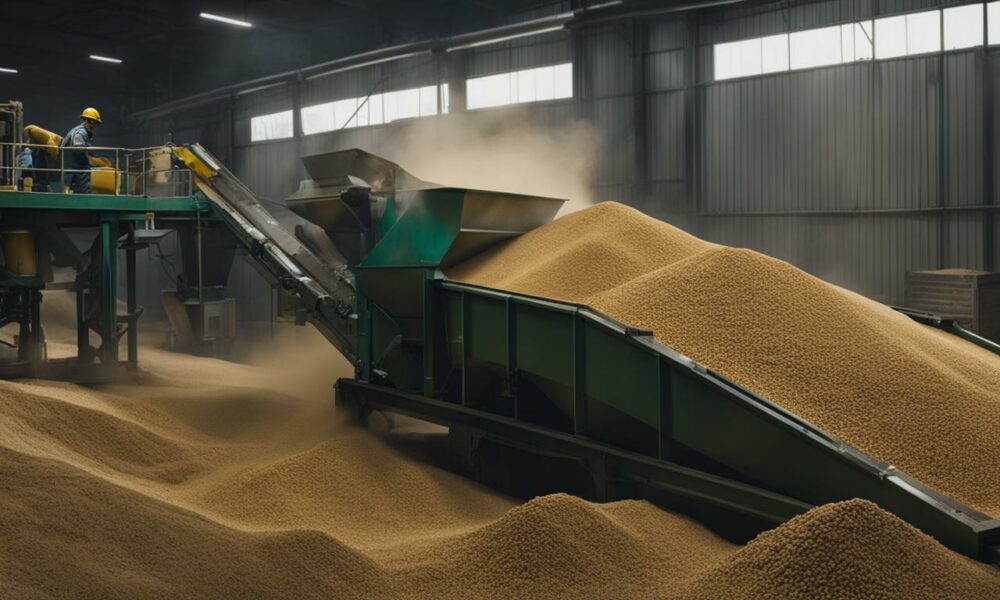
Unveiling the Process: How Vegan Protein Powder is Made
Vegan protein powder has gained immense popularity in recent years due to its numerous health benefits, environmental sustainability, and ethical manufacturing practices. But have you ever wondered how this plant-based protein supplement is made?
In this section, we will take a closer look at the vegan protein powder production process. From the selection of plant-based protein sources to the final stages of packaging and quality control, we will explore the key steps involved in creating this nutritional powerhouse.
So, let’s dive in and discover how vegan protein powder is made!
Key Takeaways:
- Vegan protein powder is a popular plant-based supplement with many health benefits.
- The production process involves selecting the right plant-based protein sources, extracting and isolating protein, purifying and filtering it, and adding flavoring, sweeteners, and texture enhancers.
- Sustainable and cruelty-free manufacturing methods are prioritized to minimize environmental impact and uphold ethical standards.
Selecting the Right Plant-Based Protein Sources
Choosing the right plant-based protein sources is crucial to the manufacturing of high-quality vegan protein powder. The ingredients used not only impact the nutritional value of the powder but also determine its taste, texture, and overall quality.
Some of the most commonly used plant-based protein sources in vegan protein powder production include:
| Protein Source | Nutritional Benefits |
|---|---|
| Brown Rice Protein | Low in fat, easy to digest, and rich in essential amino acids |
| Pea Protein | Highly digestible, rich in iron, and promotes muscle growth |
| Hemp Protein | Rich in omega-3 and omega-6 fatty acids, fiber, and essential amino acids |
It’s important for manufacturers to prioritize sustainable practices in sourcing these ingredients. This includes supporting organic farming methods and minimizing carbon footprint in transportation and packaging.
Why Sustainable Vegan Protein Powder Production Matters
By choosing sustainable practices in vegan protein powder production, we can reduce our impact on the environment while still enjoying the benefits of plant-based nutrition. This includes reducing greenhouse gas emissions, minimizing the use of pesticides and fertilizers, and supporting ethical farming practices.
Additionally, sustainable vegan protein powder production helps to ensure the continued availability of plant-based protein sources for future generations. By prioritizing sustainability, we can make a positive impact on both our health and the health of the planet.
Extraction and Isolation of Protein
After selecting the appropriate plant-based protein sources, the next step in the vegan protein powder production process involves the extraction and isolation of protein from those sources. This is a critical step in the manufacturing of vegan protein powder, as it determines the quality and purity of the final product.
“The extraction of protein from various plant sources involves the separation of protein from other components like fats, fibers, and carbohydrates. This requires the use of various processing techniques to ensure that the protein is isolated effectively.”
There are several methods used to extract protein from plants, including dry fractionation, wet fractionation, and membrane filtration. Each method has its unique advantages and disadvantages and is suitable for specific plant sources. Dry fractionation is typically used for protein-rich crops like soybeans, while wet fractionation is better suited for crops with a lower protein content.
Membrane filtration involves the use of specialized membranes to isolate protein from plant extracts. This process is particularly useful for producing highly concentrated protein powders with low impurities. Other techniques like centrifugation and precipitation can also be used to extract protein, depending on the plant source and desired outcome.
The Role of Processing Techniques
Once the protein is extracted, it undergoes further processing techniques to ensure its quality and purity. These techniques include:
| Processing Technique | Description |
|---|---|
| Heat Treatment | This involves heating the protein extract to denature any unwanted enzymes and deactivate harmful microorganisms. This step ensures the safety and quality of the protein powder. |
| Chromatography | This technique is used to separate different components of the protein extract and remove impurities. It is particularly useful for producing highly pure and concentrated protein powders. |
| Ultrafiltration | This process involves using a fine membrane to filter the protein extract and remove any remaining impurities. It is often used in combination with other processing techniques to ensure the purity of the protein powder. |
Overall, the extraction and isolation of protein is a crucial step in the manufacturing of vegan protein powder. The use of various processing techniques and methods ensures that the protein is of high quality and purity, providing a nutritious and sustainable source of plant-based protein.
Purification and Filtering
After the protein is extracted, it undergoes a purification process to remove impurities and enhance its nutritional profile. This is an essential step in creating high-quality vegan protein powder. The purification method used depends on the type of plant-based protein source used and the desired end product.
One common purification technique is chromatography, which separates the protein from other compounds based on their properties. This process involves passing the protein extract through a column containing a special resin that selectively binds to the protein. The impurities are washed away, leaving behind a pure protein concentrate.
Another technique used in vegan protein powder manufacturing is filtration. This process involves passing the protein extract through special filters that remove any remaining impurities or unwanted particles. The resulting protein concentrate is then dried to create a powder.
Comparing Purification Methods
| Purification Method | Advantages | Disadvantages |
|---|---|---|
| Chromatography |
|
|
| Filtration |
|
|
Regardless of the purification method used, the resulting protein concentrate must undergo rigorous quality control measures to ensure its safety and efficacy. This includes testing for heavy metals, microbial contamination, and other impurities. Only when the protein powder has passed all quality control tests is it ready for packaging and distribution.
Flavoring, Sweetening, and Texture Enhancement
After the protein is extracted and purified, the next step in the vegan protein powder production process involves flavoring, sweetening, and texture enhancement. These steps are crucial in creating a delicious and enjoyable product that people will want to consume.
There are various ingredients used in flavoring vegan protein powder, such as cocoa powder, vanilla extract, and fruit powders. These ingredients are added to create a range of flavors that cater to different tastes. Sweetening agents, such as stevia or monk fruit extract, are used to add a touch of sweetness without adding calories or sugar.
Texture enhancers like guar gum or xanthan gum are added to improve the mouthfeel and texture of the powder, creating a smooth and creamy consistency. These ingredients also help to prevent clumping and ensure that the powder mixes easily with liquids.
It is important to note that manufacturers must use natural and plant-based ingredients when creating vegan protein powder. Artificial sweeteners and flavorings are not allowed in vegan products, as they are not sustainable and are often associated with negative health effects.
The Importance of Natural Ingredients
Using natural ingredients not only makes vegan protein powder healthier, but it also makes the manufacturing process more sustainable. By avoiding artificial ingredients, manufacturers reduce their carbon footprint and contribute to a more ethical and eco-friendly industry.
Vegan protein powder is also healthier for the consumers, as it is free from harmful chemicals and additives. This makes it a great alternative for people who are lactose intolerant or who want to avoid animal-based products for ethical reasons.
In conclusion, flavoring, sweetening, and texture enhancement are essential steps in creating a delicious and enjoyable vegan protein powder. By using natural and sustainable ingredients, manufacturers can create a product that is not only healthy but also ethical and eco-friendly.
Packaging and Quality Control
Once the vegan protein powder is formulated, it goes through a critical packaging and quality control process. To ensure the freshness and sustainability of the product, manufacturers use eco-friendly packaging materials, such as biodegradable bags and compostable containers. This aligns with the goal of producing a fully environmentally sustainable product.
In addition to the packaging process, strict quality control measures are put in place to uphold the highest standards in cruelty-free protein powder manufacturing. These measures include testing for microbial contamination, heavy metal toxicity, and other impurities that could affect the quality and safety of the product. By ensuring the purity and cleanliness of the product, manufacturers maintain the integrity of their vegan protein powder.
Throughout this process, vegan protein powder manufacturers are committed to using sustainable and cruelty-free production methods. Their dedication to reducing environmental impact and promoting a compassionate approach to manufacturing sets them apart from conventional protein powder manufacturers. By choosing vegan protein powder, health-conscious individuals can enjoy the benefits of plant-based nutrition while supporting ethical and ecologically conscious manufacturers.
Conclusion
Understanding how vegan protein powder is made provides valuable insight into the manufacturing process. By prioritizing sustainable practices and cruelty-free manufacturing methods, we can enjoy plant-based nutrition while minimizing our environmental impact. It is essential to select the right plant-based protein sources and use the appropriate extraction and isolation methods to create a high-quality product. Purification and filtering ensure the removal of impurities, while the addition of flavoring, sweetening agents, and texture enhancers creates a delicious and enjoyable product.
Manufacturing Vegan Protein Powder with Sustainability and Cruelty-Free Practices in Mind
Following sustainable and cruelty-free practices in vegan protein powder manufacturing can help reduce our impact on the environment. It is crucial to prioritize sustainable plant-based protein sources, as well as employ environmentally-friendly packaging methods to ensure freshness and reduce waste. Implementing rigorous quality control measures can guarantee that we uphold the highest standards in cruelty-free protein powder manufacturing. With these practices in place, we can enjoy plant-based nutrition that is not only good for our bodies but also for the planet.
FAQ
How is vegan protein powder made?
Vegan protein powder is made through a process that involves extracting and isolating protein from plant-based sources. The extracted protein is then purified and filtered to remove impurities. Finally, flavoring agents, sweeteners, and texture enhancers are added to create a delicious and enjoyable product.
What plant-based protein sources are used in vegan protein powder?
Vegan protein powders can be made from a variety of plant-based protein sources such as peas, rice, hemp, and soy. These sources provide a complete amino acid profile and are rich in nutrients, making them ideal for vegan protein supplementation.
How is the protein extracted from plant sources?
The protein is extracted from plant sources using different methods such as cold-pressing, enzymatic hydrolysis, or solvent extraction. These techniques help separate the protein from other components of the plant while preserving its nutritional value.
Why is purification and filtering important in the manufacturing process?
Purification and filtering help remove impurities from the extracted protein, ensuring a high-quality and pure product. This step is crucial in enhancing the nutritional profile and taste of vegan protein powder.
What ingredients are added to vegan protein powder to enhance flavor and texture?
Vegan protein powder may contain natural flavorings, sweeteners like stevia or monk fruit extract, and texture enhancers like guar gum or xanthan gum. These ingredients are carefully chosen to create a delicious and enjoyable protein powder.
How is vegan protein powder packaged and controlled for quality?
Vegan protein powder is packaged in a way that ensures freshness and sustainability. Quality control measures are also implemented to meet the highest standards in cruelty-free protein powder manufacturing. This includes testing for purity, potency, and safety.









